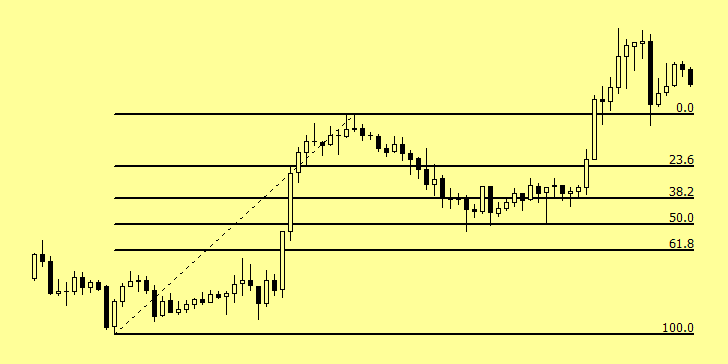
Do you use Fibonacci ratios in your trading? Like many other technical analysis tools, Fibonacci ratios can be powerful trading indicators that act as self-fulfilling prophecies due to their popularity.
Like price, support and resistance levels, volume, etc., Fibonacci levels are leading indicators. Most traders don’t use Fibonacci levels alone to take trades but combine them with other indicators in their trading system to qualify or disqualify trades.
In this article, I’m going to show you some Fibonacci retracement and extension basics as well as how you might use Fibonacci retracements and extensions in your own trading.
Fibonacci Retracement and Extension Basics
The main difference between a Fibonacci retracement and extension is that Fibonacci retracements are typically used to make a case for entering a trade, whereas Fibonacci extensions are typically used in determining where to take profits.
In the image below, you can see examples of a Fibonacci retracement and extension. To measure the Fibonacci retracement of a bearish swing (like in the example), simply measure from the high of the swing to the low of the swing. To measure the Fibonacci retracement of a bullish move, simply do the opposite (measure from low to high). In other words, measure in the direction of the swing.
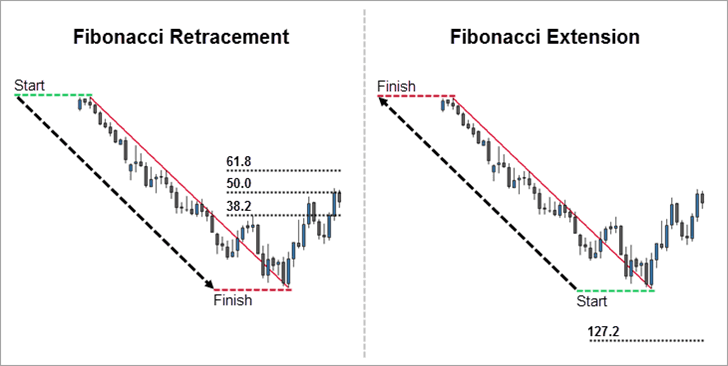
Measuring for a Fibonacci extension can vary depending on which tool you use, but the easiest way to do it is to use the regular Fibonacci retracement tool and measure backward (against the swing – as shown in the example above). This creates a Fibonacci projection in the direction of the swing, marking your potential take profit levels accurately.
Note: The MetaTrader 4 platform doesn’t include the 127.2 extension level in the default Fibonacci retracement tool, so you must add 1.272 in the properties of the tool if you want to use that common level.
Using Fibonacci Retracements
As I mentioned above, most traders use Fibonacci retracements for qualifying trade entries. If the retracement has only come down to the 23.6 level or less, there is likely to be a further retracement. A very deep retracement (one that retraces further than the 61.8 level) is often a sign that price is not likely to continue in the direction of the original swing.
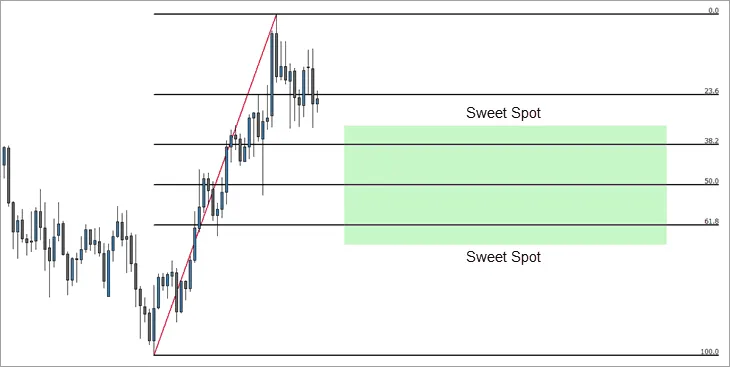
If you’re waiting to enter a trade on the retracement of a move, there is a sweet spot in which you’d like to see price bounce and hopefully continue the in the original direction. That sweet spot ranges from about the 38.2 level to the 61.8 level.
Note: The 50.0 level is not a Fibonacci ratio, but is usually included in these measurements because price reverses at the 50% retracement level so frequently.
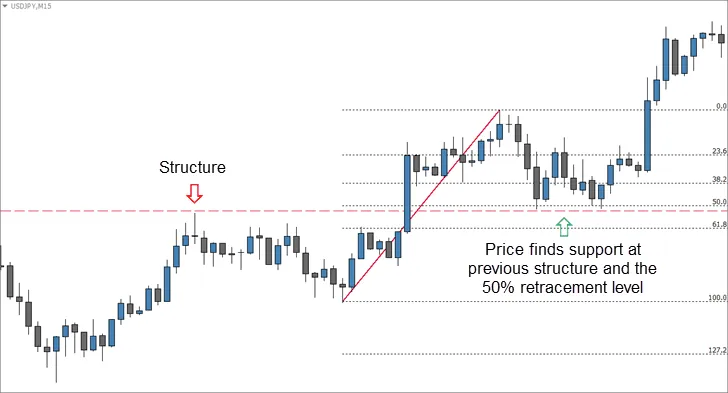
I also mentioned that Fibonacci retracements aren’t usually used alone to enter trades. Rather, they are used in combination with other factors in a trading plan to build a case (or qualify) possible entries.
Bonus: Download my free PDF report, A Profitable Fibonacci Retracement Trading Strategy. In this detailed report, you learn the exact entry, stop loss, and take profit rules of my Fibonacci retracement trading strategy and more.
In the example above, you can see a Fibonacci retracement that was drawn which shows price retracing down to about the 50% level. This wouldn’t be enough to qualify a trade entry on its own, however, the retracement also found support near previous market structure (a previous high).
In the example above, both the support level and the Fibonacci retracement levels are leading indicators. Traders often combine lagging indicators as well, like the stochastic oscillator, RSI, MACD, etc., in search overbought/oversold conditions or even hidden divergence occurring at these specific Fibonacci levels.
Using Fibonacci Extensions
Fibonacci extensions are typically used to project good take profit levels. Some traders also use Fibonacci extensions to qualify certain advanced trading strategies, like harmonic patterns.
The 127.2 and 161.8 extension levels are popular places to take profits or scale out. As a trader, you might move your stop loss to breakeven before price reaches the 100.0 level (the most recent high/low), and then scale out at 127.2, 161.8, etc.
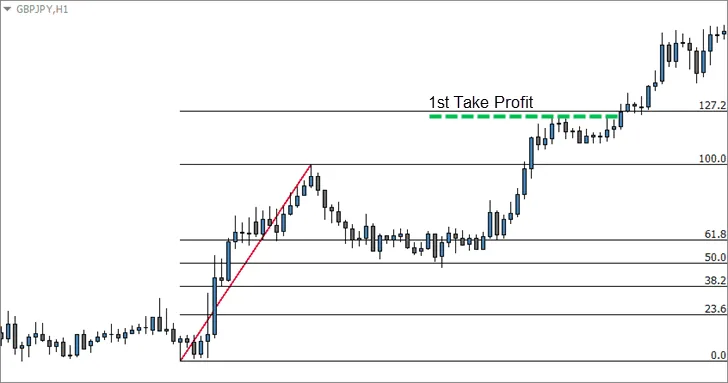
As I mentioned earlier, the easiest way to plot a Fibonacci extension is to measure backward (against the price swing) with the regular Fibonacci retracement tool. In the bullish swing above, I measured from the high of the swing to the low of the swing.
Note: If you decide to use a Fibonacci extension/expansion tool, make sure that you measure with the price swing and then back to your starting point. If you’re unsure whether or not you’re doing it the right way, just compare your levels to the levels of the preferred method that I mentioned above.
Using Fibonacci retracement and extension levels works best after strong and obvious price swings. Don’t try to force things by looking for trades where there are none.
Like any other market indicator, Fibonacci retracement and extension levels are just a tool. Using them will not magically make you a good trader if you’re not already good at trading. However, using them in combination with other market factors can help you filter out some bad trades, which is a good thing for any trader.
As always, be sure to backtest and demo trade any new trading techniques before adding them to your live trading repertoire. Do you use Fibonacci retracement and extension levels in your own trading? Do you use different techniques than the ones I’ve described above? Please let me know in the comments below.


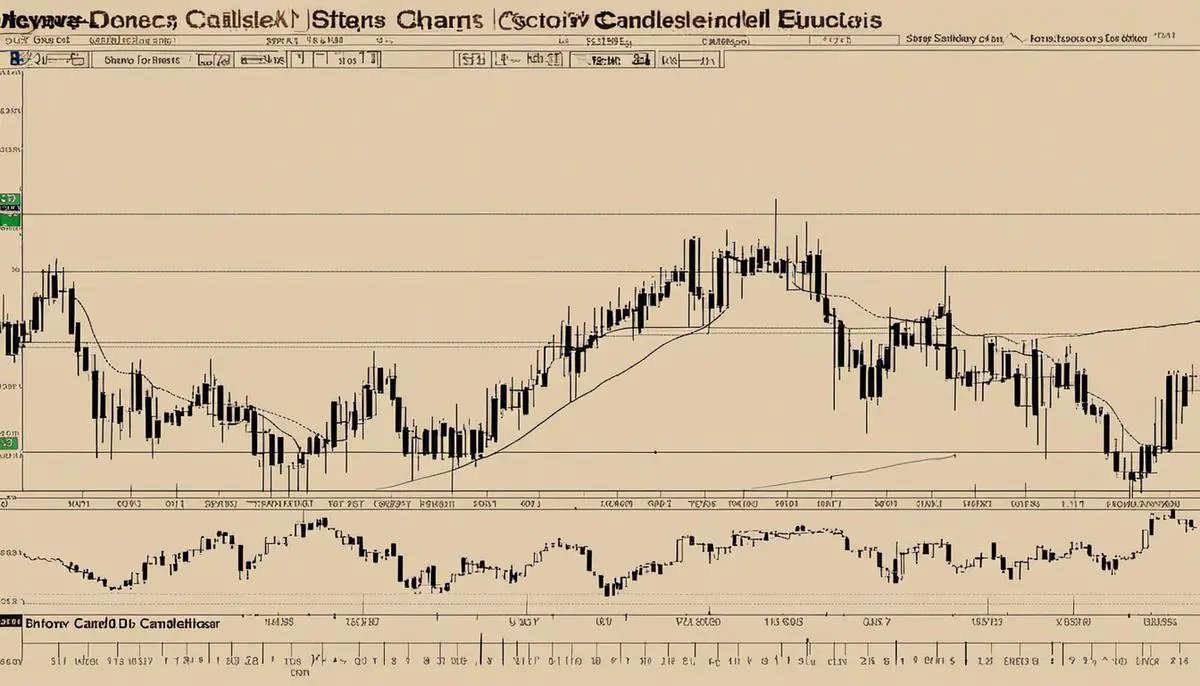

All that I want is to know when to stop loss, when to take profit and when to enter a trade.
Newsletter subscribers got a bonus Fibonacci trading strategy when this article came out. I can resend that email to anyone that’s interested.
Edit: I’ve added the strategy to this page as a free PDF download.
Hey bro, I have signed up but I have forgotten to enter my name and the + Fib along to get the bonus. Do you mind to send it to me? Thanks a lot
Hey Vic, thanks for signing up. Glad to have you. I sort of forgot about this, and to tell you the truth, you’re the first person that wanted the strategy.
I had planned to make a downloadable PDF that detailed the strategy as a bonus to this article. It will be more detailed than the newsletter. Let me work on this today, and you’ll be the first person to get it.
Edit: I’ve emailed the PDF to you, and I’ll be adding it to this page shortly for everyone else to download.
would love the PDF ; and you are very helpful !
Mr.Chris if you are scalping do you draw your fib on the hour or 15m chart?
if you are day trading do your your fib on the daily or 4H chart?
I will love to get the fib strategy. My email is [edited]
I need a support and resistance indicator please. Your article was fantastic keep it up.
Thanks for the kind words. I’m not a big fan of support and resistance indicators because they usually do a terrible job of choosing significant support and resistance levels. To learn how to choose your support and resistance levels like I do, you should get my free eBook.
That being said, I did share a good support and resistance indicator with my readers a while back. I shared it because it doesn’t actually choose levels based on past market structure. It plots levels based on the pivot points of the daily candlesticks.
That is a significant distinction because those levels often act as support and resistance and the indicator doesn’t need to be very intelligent to plot them.
The downside is that since this indicator is based on the daily candlesticks, it only really plots useful levels on the lower time frames, such as the 15-minute chart.
Unfortunately, spotting regular support and resistance levels that are based on the structure of the market is still best done with a trained, human eye. The good news is that it’s not that hard and can actually be quite mechanical once you learn the right techniques.
Dearest Chris, you are doing a tremendous job for new as well as experienced traders, your explanation is appreciated. I wish all the successes to you in every wake of life for your great work.
Thanks for the kind words, brother. I’m glad you’re finding this site useful. Good luck to you!
Hi Chris,
What is the “Scale out”?
Thanks.
Scaling out is what traders call partially closing a trade at an initial profit target. Traders may do this 2 to 4 times or more until their trade is completely closed. An example would be to close half of your position once a 1:1 reward to risk is reached, leaving the other half to trade with a profit target of 1:2 or 1:3 before fully closing the trade.
Chris, Thanks alot for your nice turorials!
Thanks for reading and sharing them!
would love the PDF ; and you are very helpful !
Mr.Chris if you are scalping do you draw your fib on the hour or 15m chart?
if you are day trading do your your fib on the daily or 4H chart?
Hey Bryson,
To get the PDF, simply enter your email address (by clicking on the bonus box in the article). You’ll have to confirm that you want to receive emails from me from your email account. After that, you’ll receive an email with downloads to that ebook as well as my other one.
As far as which time frame to use your Fib on. It depends on your strategy. I have personally only ever used Fibonacci levels on the chart I was trading from. I haven’t tried to draw Fibonacci levels on, for example, the daily chart to use while taking entries on the 4H chart. That would be interesting to test, though.
Thanks for your interest. Good luck!
i really like ur work chris. simple and accurate was hoping to get the PDF also pls n thank you.
Hey Samuel,
To get the PDF, simply enter your email address (by clicking on the bonus box in the article). You’ll have to confirm that you want to receive emails from me from your email account. After that, you’ll receive an email with downloads to that ebook as well as my other one.
Thanks for your interest!
Hi Chris, thank you so much, I am learning a lot through you, keep up the good job, you are a blessing to us.
Thanks for the kind words, Peter. I’m glad you’re finding my site useful. Good luck!
Thank you very much for the Fibonacci explanations, they were easy to understand and straight to the point, thank you once again
I’m glad you found this helpful. Thanks for visiting!
Hey Chris, thank you for awesome explanation of Fibonacci retracements. was easy to understand and backtest it with my current strategy. Thanks again.
Glad you found it useful. Good luck!
Hi Chris, thank you for this explanation! I wanted to fill in my email in your Bonus box to receive the Pdf explanation but somehow there is no link! Please help me. Thank you!
Hey, Alan. You should have received an email from me entitled “Confirm Your Download”. Be sure to check your SPAM folder. There’s a link in that email to confirm your email address. Once clicked or pasted into your browser, you’ll be redirected to the page with the downloads.
If you’ve already confirmed your email, you can also click on the Bonus link again. It will say you’re already subscribed and just give you the link to the downloads page directly. Hope that helps.
Thanks for reading and signing up! I’ve got some good stuff coming exclusively for all of you that have subscribed to my newsletter. Stay tuned!
Graet work Sir. May I have the PDF version?
Sure. Just click the link in the post above (in the section marked Bonus).
Enter your info, so I can send it to you.
After you confirm your email address, you’ll receive the download instantly.
Hi Chris,
Please send me the Fibonacci Strategy and if possible also the Support and Resistance Indicator.
I find that your Articles and Explanation Simple and Clear.
Like All your Readers Thank You for your Kindness, Generosity and Sharing which gives Clarity in this FX World to Us All…
Anil
Hey Anil,
Thanks for the kind words! I see that you’ve signed up to the newsletter, so you probably already got one of those.
Note: I just updated the Fibonacci Strategy eBook this morning. If the one you downloaded doesn’t have an image on the first page that says “Second Edition” on the spine, you’ve got the old one.
You can just click on the link in this article again to get the new one. The system will recognize that you’re already subscribed and just give you the link you need.
Also, I’m actually planning to get a downloads page put up today, so if you’re already subscribed, you can download both eBooks (and something new) from that page.
So, stay tuned. I’m working on it right now. Thanks!